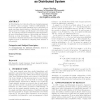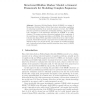2373 search results - page 2 / 475 » Complexities for generalized models of self-assembly |
ICS
2010
Tsinghua U.
13 years 9 months ago
2010
Tsinghua U.
: Perhaps the two most significant theoretical questions about the programming of self-assembling agents are: (1) necessary and sufficient conditions to produce a unique terminal a...
DFT
2008
IEEE
13 years 12 months ago
2008
IEEE
Error detection/correction techniques have been advocated for algorithmic self-assembly. Under rectilinear growth, it requires only two additional tiles, generally referred to as ...
DNA
2006
Springer
13 years 9 months ago
2006
Springer
We study the times to grow structures within the tile self-assembly model proposed by Winfree, and the possible shapes that can be achieved. Our earlier work was confined to the g...
PODC
2009
ACM
14 years 6 months ago
2009
ACM
In 2004, Klavins et al. introduced the use of graph grammars to describe--and to program--systems of self-assembly. It turns out that these graph grammars can be embedded in a gra...
AIIA
2007
Springer
13 years 11 months ago
2007
Springer
Structured Hidden Markov Model (S-HMM) is a variant of Hierarchical Hidden Markov Model that shows interesting capabilities of extracting knowledge from symbolic sequences. In fact...


